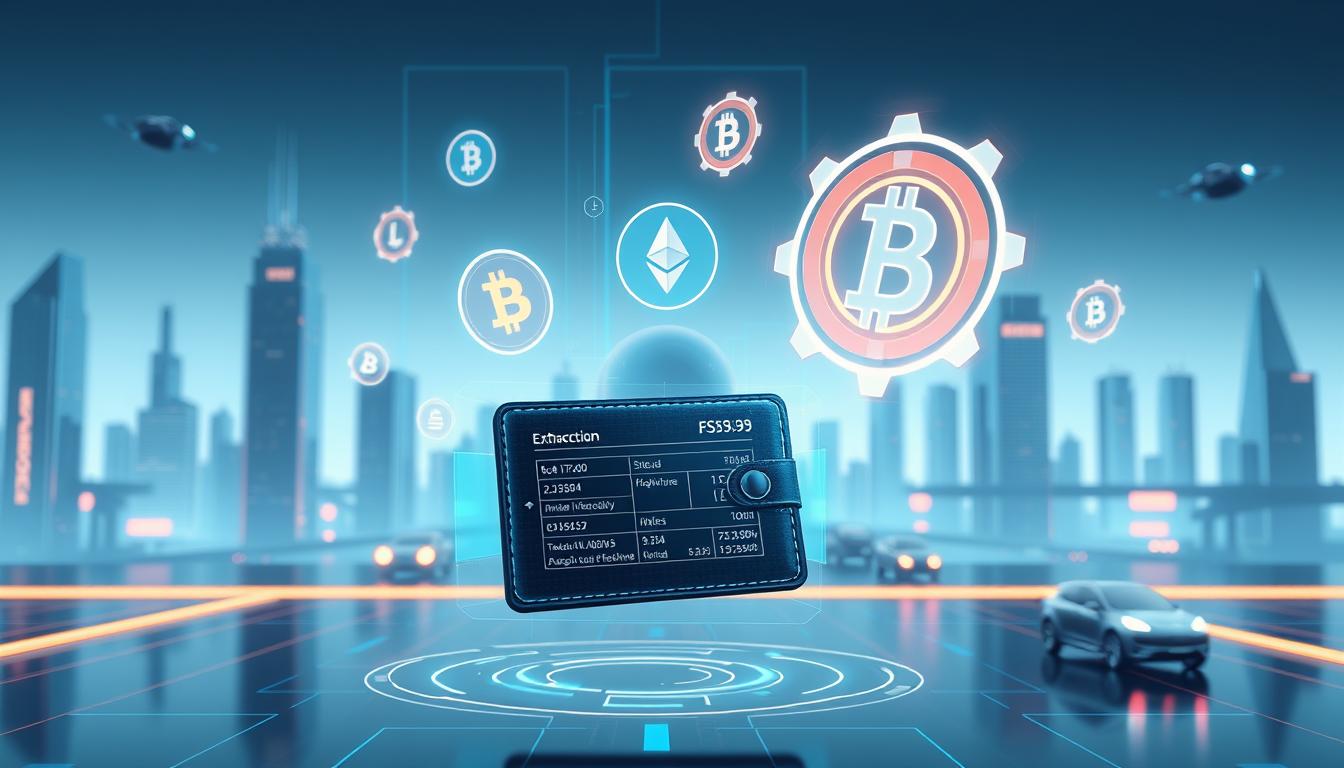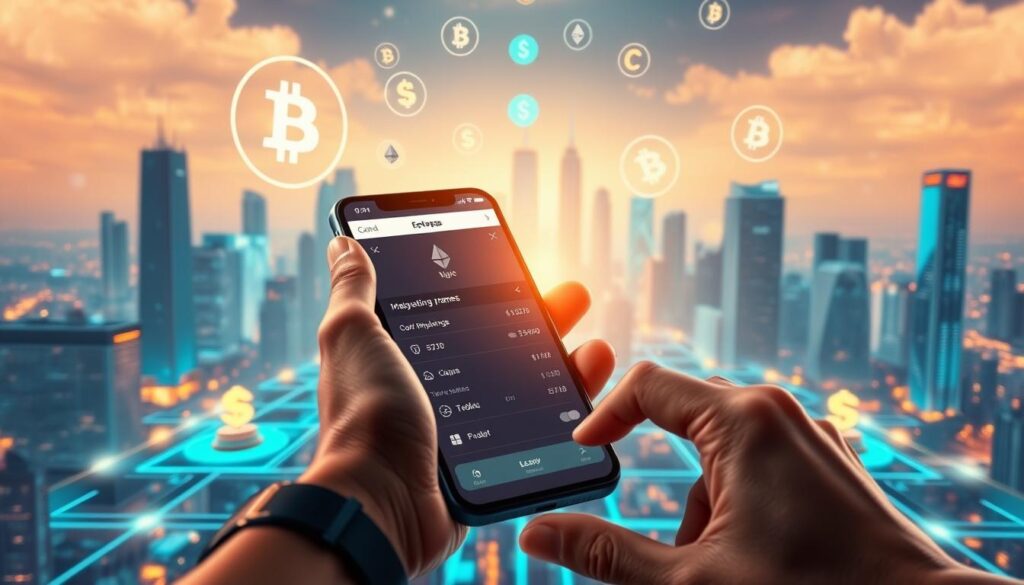Now Reading: Cryptocurrency medium of exchange payments Explained
- 01
Cryptocurrency medium of exchange payments Explained
Cryptocurrency medium of exchange payments Explained

Money is changing. For centuries, we have relied on paper bills and metal coins issued by governments. Today, a new form of value is emerging from the digital world.
This new type of digital asset is called cryptocurrency. It exists only online. Unlike traditional currency, it operates without a central bank or government control.
The core idea is powerful. These digital currencies allow people to send value directly to each other. This peer-to-peer system cuts out the middleman for financial transactions.
This guide will walk you through how crypto works as a modern payment tool. We will explore its unique technology and how you can use it.
Key Takeaways
- Digital currencies offer a new way to handle money outside traditional systems.
- They enable direct transfers between people without banks.
- This technology is decentralized, meaning no single entity controls it.
- Understanding this system is key to using it for everyday purchases.
- The value of these assets comes from technology and market demand.
Introduction to Cryptocurrency Payments
Online assets built on cryptographic principles are redefining monetary systems. These digital tools represent a fundamental shift from government-issued money. They operate through innovative technology that ensures security and transparency.
What Are Cryptocurrencies?
Cryptocurrencies are virtual forms of value secured by advanced mathematics. This cryptographic protection makes counterfeiting virtually impossible. Unlike traditional currency, they function without central authority control.
The underlying blockchain technology serves as a public ledger. This distributed network records every transaction across multiple computers. Each block contains ownership information and connects to previous entries.
How Digital Assets Are Changing Transactions
Digital assets transform how people exchange value globally. They eliminate intermediaries like banks from the payment process. This peer-to-peer system reduces costs and speeds up settlements.
The decentralized nature of crypto enables borderless transactions. Users can send funds directly worldwide without currency conversion fees. This technology creates a more inclusive financial system.
| Feature | Traditional Systems | Digital Assets |
|---|---|---|
| Control Authority | Central banks and governments | Decentralized network consensus |
| Transaction Speed | Days for international transfers | Minutes regardless of location |
| Verification Process | Third-party intermediaries | Network participants collectively |
| Cost Structure | Various fees and commissions | Typically lower transaction costs |
| Accessibility | Bank account required | Internet connection sufficient |
Benefits of Using Cryptocurrency as a Medium of Exchange
When comparing digital payment methods, crypto assets demonstrate clear superiority in several key areas. These advantages make them attractive for everyday financial activities.
Lower Transaction Costs and Faster Settlement
Digital transfers eliminate intermediaries that typically add fees. This results in significant cost savings for users.
Many blockchain transactions cost just pennies compared to traditional bank fees. International transfers that normally take days can settle in minutes.

Enhanced Privacy and Global Accessibility
Users maintain greater control over their personal information. The system verifies transactions without exposing sensitive data.
Anyone with internet access can participate in the global economy. There are no geographic restrictions or currency conversion hurdles.
| Benefit | Traditional Systems | Crypto Assets |
|---|---|---|
| Transaction Cost | High fees for international transfers | Typically under a few dollars |
| Settlement Time | 1-5 business days | Minutes to hours |
| Privacy Level | Extensive personal data sharing | Pseudonymous transactions |
| Global Access | Bank account and geographic limits | Internet connection only |
| Border Transfers | Currency conversion fees apply | Direct peer-to-peer exchange |
Cryptocurrency Medium of Exchange Payments
At the core of digital currency functionality lies a unique architecture that enables direct value exchange. This system operates fundamentally differently from traditional financial networks.
Understanding the Unique Functionality
Digital assets rely on advanced cryptographic systems to secure every transaction. This technology verifies authenticity without central authority oversight.

The peer-to-peer nature allows value to transfer directly between parties. This eliminates banks and payment processors from the process.
Each unit of a particular crypto asset holds identical value as any other unit. This fungibility makes digital currencies function like traditional money for exchange purposes.
| Functional Aspect | Traditional Systems | Crypto Systems |
|---|---|---|
| Verification Method | Third-party intermediaries | Network consensus |
| Transaction Privacy | Personal data exposure | Pseudonymous records |
| Settlement Speed | Business days required | Near-instant confirmation |
| Global Accessibility | Geographic restrictions | Borderless operation |
Merchants increasingly integrate crypto options into checkout systems. Both online and physical purchases now accept these digital assets.
Transactions provide user privacy while creating transparent, public records. This dual nature prevents fraud and enables trustless exchange.
The technology excels for micropayments and international transfers. Rapid settlement makes digital payment ideal for time-sensitive transactions.
Understanding Blockchain Technology in Transactions
The engine powering secure digital value transfers is a revolutionary technology called blockchain. This system creates a transparent record that everyone can trust without central authority control.

Blockchain operates as a digital ledger spread across countless computers worldwide. Each participant maintains an identical copy of the transaction history.
The Role of Decentralization
Decentralization means no single entity controls the entire network. Instead, thousands of computers work together to verify and record transactions.
This distributed approach creates tremendous security through redundancy. The system reaches consensus about transaction validity without intermediaries.
Ensuring Security Through Cryptographic Protocols
Advanced cryptography protects every aspect of blockchain operations. Mathematical algorithms secure ownership information and prevent tampering.
Each transaction block connects cryptographically to the previous one. This creates an unbreakable chain that becomes more secure over time.
| Feature | Traditional Ledgers | Blockchain Systems |
|---|---|---|
| Data Storage | Centralized databases | Distributed across network |
| Verification Process | Single authority approval | Network consensus required |
| Transaction History | Can be modified or erased | Permanent and immutable |
| Security Model | Trust in central institution | Trust through cryptography |
| Transparency Level | Limited access to records | Fully visible to participants |
This technology has applications beyond digital currencies. Supply chain management and smart contracts also use blockchain principles.
Risks and Challenges in Cryptocurrency Payments
Navigating the world of crypto assets involves understanding significant potential pitfalls. While digital currencies offer innovative solutions, they come with unique challenges that demand careful attention.
Market Volatility and Price Fluctuations
Digital currencies experience dramatic price swings that can impact their value quickly. Bitcoin’s journey demonstrates this volatility clearly.
The asset surged to nearly $65,000 in November 2021 before dropping significantly. Such fluctuations create uncertainty for everyday transactions and long-term investment strategies.
Security Concerns and Wallet Management
Protecting your digital assets requires diligent security practices. Losing your private key means permanent loss of access to your holdings.
Unlike traditional finance, transactions cannot be reversed once completed. This places greater responsibility on users to verify every transfer carefully.
| Risk Category | Traditional Finance | Crypto Assets |
|---|---|---|
| Transaction Reversibility | Chargebacks possible | Irreversible once sent |
| Price Stability | Generally stable | Highly volatile |
| Recovery Options | Account recovery available | No key recovery |
| Regulatory Protection | Established frameworks | Uncertain status |
| Third-Party Risk | FDIC insurance available | No deposit insurance |
Fraud remains a substantial concern in the crypto space. Fake investment platforms and phishing schemes target unsuspecting users regularly.
Exchange hacks have resulted in millions lost over the years. Investors must research platforms thoroughly before trusting them with assets.
Comparing Cryptocurrency to Traditional Fiat Payments
The fundamental architecture of value transfer presents two distinct paths in today’s economy. One follows centuries-old systems managed by central authorities. The other operates through decentralized networks using digital technology.
Differences in Regulation and Transaction Processing
Traditional systems rely on government backing and bank intermediation. National currencies like U.S. dollars derive value from legal tender status. This creates stable but centralized control over monetary policy.

Digital assets function without central bank management. Their value comes from network consensus and adoption. This creates a fundamentally different regulatory environment for transactions.
Consumer protections vary significantly between systems. Traditional banking offers deposit insurance and fraud reversal options. Digital asset buyers assume greater personal responsibility for security.
| Aspect | Traditional Payments | Digital Asset Payments |
|---|---|---|
| Issuing Authority | Central banks and government | Decentralized network algorithms |
| Transaction Verification | Banks and financial institutions | Network participants globally |
| Regulatory Framework | Established banking laws | Evolving SEC guidelines for exchanges |
| Consumer Protection | FDIC insurance available | Limited recourse options |
| Global Accessibility | Geographic restrictions apply | Borderless network access |
Regulatory approaches continue evolving for digital assets. The SEC now oversees crypto exchanges and institutional offerings. This creates growing compliance requirements for companies operating in this space.
How to Start Using Cryptocurrency for Everyday Transactions
Getting started with digital assets requires just two essential tools. You need a place to acquire them and a secure location to store them.
This practical guide walks you through the initial setup process. We’ll cover everything from choosing platforms to making your first purchase.
Setting Up Your Digital Wallet
Your digital wallet stores the keys needed to send and receive coins. Think of it as a secure digital vault for your assets.
There are two main wallet categories to consider. Hot wallets connect to the internet for easy access.
Cold wallets remain offline for maximum security. These include hardware devices and paper options.
Security should guide your wallet choice. Cold storage offers better protection for larger amounts.
Remember: lost keys mean lost access permanently. Always create secure backups of your credentials.
Selecting a Reliable Cryptocurrency Exchange
Exchanges are marketplaces where you convert traditional money into crypto. Platforms like Coinbase and Gemini offer user-friendly interfaces.
The account setup process involves identity verification. This ensures security and regulatory compliance.
Once verified, you can fund your account. Then simply enter the ticker symbol and amount to purchase.
Consider transaction fees and supported coins when choosing. Some platforms cater better to beginners than others.
Tax and Regulatory Considerations for Cryptocurrency Transactions
Tax obligations represent a critical consideration for anyone using crypto for transactions. Government agencies have established specific rules that differ from traditional financial systems.
The IRS classifies digital assets as property rather than currency. This means every transaction creates potential capital gains tax implications.
IRS Guidelines on Capital Gains
When you purchase goods with digital assets, you’re effectively selling a portion of your holdings. The taxable amount is calculated by comparing the fair market value against your original cost basis.
Proper capital gains calculation requires tracking purchase prices and transaction dates. Failure to report gains accurately can result in significant penalties.
This applies to both trading activities and everyday purchases. Many investors overlook tax responsibilities when using crypto for small transactions.
SEC Regulations and Market Oversight
The SEC oversees crypto exchanges and certain digital asset offerings. Recent court rulings have clarified that institutional purchases may qualify as securities transactions.
In 2024, the SEC approved Bitcoin exchange-traded products for the first time. This marked a significant milestone for mainstream investment acceptance.
International regulations like Europe’s MiCA framework establish standards for companies offering crypto services. The regulatory landscape continues evolving across global markets.
Thorough research and professional tax consultation are essential for compliance. Maintaining detailed records protects investors in this rapidly changing environment.
Future Trends in Cryptocurrency Medium of Exchange Payments
Looking ahead, the trajectory of digital asset adoption suggests significant transformations in financial infrastructure. Emerging technologies promise to enhance transaction efficiency and expand use cases beyond simple value transfers.
Emerging Technologies and Evolving Markets
Layer-2 scaling solutions are making transactions faster and cheaper. These innovations address current limitations in blockchain networks.
Smart contract technology enables automated financial agreements. Platforms like Ethereum support complex decentralized applications.
The market continues maturing with increased institutional investment. Major financial institutions now explore blockchain for internal operations.
Potential Impact on Traditional Banking
Traditional banks face both competition and collaboration opportunities. Some institutions integrate crypto services alongside conventional offerings.
Central bank digital currencies represent government responses to decentralized alternatives. These may coexist with or compete against existing cryptocurrencies.
Long-term investing in this space requires careful research. The technology shows promise but remains relatively young.
Conclusion
The journey through cryptocurrency fundamentals reveals both transformative potential and substantial challenges. Digital assets offer innovative ways to transfer value globally through decentralized networks.
However, these investments carry significant risk due to market volatility and regulatory uncertainty. Cryptocurrency may not suit all investors, especially those who cannot afford to lose their funds.
Thorough research and professional guidance are essential before engaging with these assets. The blockchain technology behind crypto continues evolving, presenting both opportunities and risks.
Approach cryptocurrencies with caution, recognizing their dual nature as innovative tools requiring careful management. Always consult qualified financial advisors for personalized advice.
FAQ
What is a digital asset, and how is it used for payments?
A digital asset is a form of ownership that exists in electronic form, like Bitcoin or Ethereum. These assets can be used for payments by sending them directly to another person’s wallet, bypassing traditional banks. This allows for peer-to-peer transactions across the globe.
Why are transaction costs often lower with crypto compared to credit cards?
Using crypto for payments can cut costs because it removes intermediaries like banks and payment processors. The network fees for verifying transactions are typically much lower than the percentage fees charged by companies like Visa or Mastercard, especially for international transfers.
How does blockchain technology make these transactions secure?
Blockchain security comes from its decentralized nature and cryptographic protocols. Each transaction is recorded on a public ledger that is maintained by a network of computers, making it extremely difficult to alter or hack. This technology ensures the integrity of every payment.
What is the biggest risk when using crypto for everyday purchases?
The primary risk is market volatility. The value of a coin like Bitcoin can change rapidly against the US dollar. This means the price of an item you buy could be significantly different in dollar terms just hours after the transaction settles, unlike stable fiat currency.
Do I need to pay taxes on things I buy with cryptocurrency?
Yes, in the United States, the IRS treats using crypto to buy goods as a taxable event. You may owe capital gains tax based on the increase in the asset’s value from when you acquired it to when you spent it. It’s crucial to keep records of all your transactions for tax reporting.
How do I choose a wallet and an exchange to start using crypto for payments?
Start by researching reputable exchanges like Coinbase or Kraken to buy your initial digital assets. For a wallet, consider security features. A hardware wallet from a company like Ledger offers strong protection for storing larger amounts, while mobile wallets are convenient for smaller, daily transactions.
How might crypto payments affect traditional banking in the future?
As adoption grows, crypto could challenge banks by offering faster, cheaper, and more accessible financial services. This might push traditional institutions to innovate and integrate blockchain technology to stay competitive, potentially changing how we all manage money.














